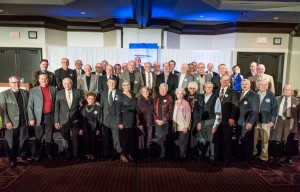Category Archives: Uncategorized
September 19, 2018
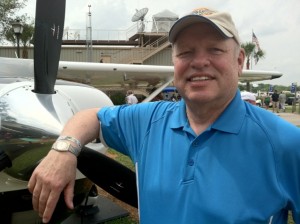
Dave Franson
I used to be a pilot. Oh, I still hold a certificate that says I’m licensed to fly an Airplane, Single-Engine, Land (ASEL), but I haven’t done so in over a decade. As it turns out, not alone. Far from it. The latest figures indicate that we’re losing approximately 6,000 pilots per year in the U.S.
In my case, the FAA is probably glad I’m among them. When I was still flying, the controllers in the tower at Wichita Mid-Continent Airport recognized my voice…or maybe it was my erratic style. They used to practice evacuation drills when I entered the pattern. I discovered they had a term for my landings: “Dribbling.” When they heard I was considering paying my flight instructor to give me a biennial flight review and sign me off to get back into the air, they took up a collection and paid him not to. When I asked him what he thought about an instrument rating, he recommended I consider the clarinet.
But, the economics of being a recreational pilot have become almost prohibitive, anyway…and that’s a concern, because it also means learning to fly and owning a personal airplane is harder to justify, too. The average price of a general aviation aircraft nearly doubled from 2007 to 2010. Buying a new Cessna 172 will cost more than $300,000 and a new diesel 182 starts at $515,000.
The Aircraft Owners and Pilots Association (AOPA) and the Experimental Aircraft Association (EAA) have endorsed programs to ease the medical requirements for private pilots, substituting a valid driver’s license in certain circumstances. AOPA has also recently issued guidelines on how to form a flying club and acquire a used airplane, with the intent of expanding the opportunities for dormant pilots like myself.
The publisher of Av-Web, an industry on-line news service, launched an initiative to Rebuild, Restore, and Re-equip the GA fleet, updating restorable aluminum aircraft to modern capability at a price that is affordable. In more recent days, he’s also created a program to challenge current pilots and aircraft owners to issue an “Invitation to Fly” to their friends, neighbors, lapsed pilots and youngsters who haven’t paid attention to private aviation in recent years.
Back in 2013, the Small Airplane Revitalization Bill was introduced by then-Congressman Mike Pompeo. President Obama signed it into law. It was designed to streamline the certification process and increase safety for production aircraft, potentially eliminating some of the costs associated with the introduction of new models. Savings were to be passed onto the consumers. Unfortunately, the market for the affected models—personally flown, primarily single engine airplanes—remained basically flat and any stimulation that might have been generated by a less cumbersome regulatory process was virtually neutralized by a lack of market enthusiasm.
Locally, GlobalParts.aero tried to boost interest with a very interesting approach: they acquired the Type Certificate, intellectual property, tooling, and assets of the Meyers Aircraft Model 200. They offered their up-to-date servicing and support network for operators of the high performance single engine model which was originally certified in the 1960s. Though it was designed half a century ago, the Meyers 200’s performance, economy and versatility are still competitive in today’s market, too. But, GlobalParts.aero hasn’t been able to generate much enthusiasm, either and is now assessing ways it might utilize its innovative capabilities to expand the potential of this iconic, affordable, owner flown airplane.
Yingling Aviation also took a creative approach. They acquired some 25-30 year old Cessna 172N Skyhawk airframes and completely refurbished and updated the airplanes so that they were virtually identical to the production model 172s rolling off the Cessna/Textron line in Independence. The Ascend 172 from Yingling is a masterfully reconditioned aircraft that is a viable alternative for flight schools, flying clubs and individuals who don’t have or want to spend close to half a million dollars for a four-place, 120 mile per hour single engine airplane. But, even though it’s priced at about half the cost of its current production offspring, the Ascend 172 hasn’t revitalized the market, either.
All of the recent efforts to re-invigorate the lower end of the GA marketplace are laudable and deserve some consideration. But, none of them have come up with a way for the manufacturers to make money on personal airplanes. Cirrus and Piper have supplanted Cessna and Beech as the major producers of single engine piston aircraft, but even they can’t keep the cost of their products at a level that’s compatible with a middle class income. Simulators are taking a greater percentage of the training workload and older—and increasingly outdated—airplanes are being flown until they are forcibly retired by a lack of parts to keep them in the air. With the coming of the Next-Gen Air Traffic Control system and its requirements for ADS-B and digital navigation and communications capabilities, many of the legacy airplanes that are the staples of flight schools and flying clubs will also be grounded. In the not-too-distant future it’s likely 100LL burning aircraft will be grounded by regulations which restrict the use and availability of leaded fuel, too.
So, what’s the answer? There’s probably a market out there for reconditioned, like-new training, flying club and personally owned airplanes, but it’s nothing like the one that existed in the days before the threat of unrestrained product liability litigation nearly killed it. Even the General Aviation Revitalization Act of 1996 wasn’t enough to restore
what had once been the industry’s most prolific segment. Perhaps the answer lies in a joint effort among airframe manufacturers, home builders, and the government to create an environment—and aircraft—that can be used by prospective students who are inspired and excited about replacing the current generation of pilots who are retiring. It will take cooperation and some serious promotional efforts to convince the next generation to put down their devices long enough to consider taking the controls of an aircraft.
We’ll also have to persuade these prospective aviators that they won’t be losing their jobs to robots and pilotless “Air Ubers.” Finally, as an industry, we have to agree to take a more serious and unified approach to preserving the aircraft, equipment, techniques and support structure that already exists. It’s worth it to keep many of our smaller local airports from becoming “bone yards” and both personal flying and “hangar flying” from becoming lost art forms. General aviation and its heritage are too valuable to lose. We must work together to keep it going. You might say it’s the “Wright thing” to do!
September 12, 2016
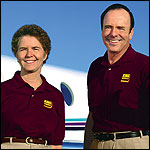 Wichita, KS—John and Martha King may be among the most recognizable people in general aviation. Literally millions of GA pilots have taken flight instruction from them. They certainly are two flight instructors who have received more recognition—as in honors and awards—than any others, because their video flight training programs are not only exceptionally popular, they’re also exceptionally good! King School students start as beginners and can carry on until they become Air Transport Pilots or Certified Flight Instructors themselves. John and Martha have helped more than half a million pilots reach their aviation goals and their courses are so effective that more than 98% of their customers pass their FAA exams on their first try! No wonder they’re considered Flight Training “royalty.” Of course, having the surname “King” probably doesn’t hurt either! Whatever the reason, they’re bona fide experts on what’s happening when it comes to learning to fly—a subject that’s always been an extremely important one in Wichita, where more flight training aircraft have been built than anywhere else in the world. Join Us for Lunch! On Thursday, October 6, 2016 at noon, John and Martha will address the Wichita Aero Club luncheon in the Tapestry Dining Room at the Crestview Country Club located at 1000 North 127th Street East, between 13th Street and Central Avenue. It will be the first time that the WAC has met at Crestview for a luncheon. The Club is the site for the Aero Club’s annual Golf Classic each June. “We’re looking forward to hearing from the Kings on October 6,” said Dave Franson, president of the Wichita Aero Club, “because they are literally the world’s leaders in flight education. They have made pilot education available to the masses by putting their training seminars—which are exceptionally clear and easy to follow—on video and staying abreast of the technological advances and making those videos compatible with virtually all the multimedia devices. They are the first and only husband and wife to both hold every category and class of FAA pilot and instructor certificates. That also means they know what is happening in the flight instruction marketplace—how it is changing and evolving. How simulation is affecting it; how the aging fleet and the rising cost of new aircraft is impacting it. They certainly can offer some insight into the perceived future pilot shortage as the number of military and civilian trained pilots declines and the industry faces the concept of UAVs and drones in a re-defined and re-regulated next generation airport and airspace environment. I’m not trying to put a lot of pressure on them to address a lot of difficult issues, but these are two people for whom I have tremendous respect and I’m really anxious to hear their insight into the future of flight training because it all starts there.” The Wichita Aero Club luncheon will begin at noon at Crestview. Ample parking is available at the Country Club, which is located approximately half a mile east of the intersection of 13th Street and K-96 in East Wichita. The main entrance to the site is midway between 13th Street and Central on 127th Street East. Parking is available both to the north and south of the main Clubhouse. The luncheon is being held on the same day as the Economic Outlook Conference hosted by Wichita State University’s Center for Economic Development and Business Research (CEDBR) at Century II, which will also feature an aerospace panel consisting of Teal Group Analyst Richard Aboulafia, WAC Member and Cox Machine President, Jason Cox and WAC President Dave Franson. The EOC Aerospace event will conclude before the mid-morning break and the entire conference will end at 11:30 AM. Attendees of the EOC who wish to attend the WAC luncheon will be offered the WAC member discount of 25% simply by showing their name badge or ticket at the door. Cost of the WAC luncheon is $40 for non-members, $30 for members. Tickets may be purchased at the door or on-line at www.wichitaaeroclub.org using Pay Pal or credit card.
Wichita, KS—John and Martha King may be among the most recognizable people in general aviation. Literally millions of GA pilots have taken flight instruction from them. They certainly are two flight instructors who have received more recognition—as in honors and awards—than any others, because their video flight training programs are not only exceptionally popular, they’re also exceptionally good! King School students start as beginners and can carry on until they become Air Transport Pilots or Certified Flight Instructors themselves. John and Martha have helped more than half a million pilots reach their aviation goals and their courses are so effective that more than 98% of their customers pass their FAA exams on their first try! No wonder they’re considered Flight Training “royalty.” Of course, having the surname “King” probably doesn’t hurt either! Whatever the reason, they’re bona fide experts on what’s happening when it comes to learning to fly—a subject that’s always been an extremely important one in Wichita, where more flight training aircraft have been built than anywhere else in the world. Join Us for Lunch! On Thursday, October 6, 2016 at noon, John and Martha will address the Wichita Aero Club luncheon in the Tapestry Dining Room at the Crestview Country Club located at 1000 North 127th Street East, between 13th Street and Central Avenue. It will be the first time that the WAC has met at Crestview for a luncheon. The Club is the site for the Aero Club’s annual Golf Classic each June. “We’re looking forward to hearing from the Kings on October 6,” said Dave Franson, president of the Wichita Aero Club, “because they are literally the world’s leaders in flight education. They have made pilot education available to the masses by putting their training seminars—which are exceptionally clear and easy to follow—on video and staying abreast of the technological advances and making those videos compatible with virtually all the multimedia devices. They are the first and only husband and wife to both hold every category and class of FAA pilot and instructor certificates. That also means they know what is happening in the flight instruction marketplace—how it is changing and evolving. How simulation is affecting it; how the aging fleet and the rising cost of new aircraft is impacting it. They certainly can offer some insight into the perceived future pilot shortage as the number of military and civilian trained pilots declines and the industry faces the concept of UAVs and drones in a re-defined and re-regulated next generation airport and airspace environment. I’m not trying to put a lot of pressure on them to address a lot of difficult issues, but these are two people for whom I have tremendous respect and I’m really anxious to hear their insight into the future of flight training because it all starts there.” The Wichita Aero Club luncheon will begin at noon at Crestview. Ample parking is available at the Country Club, which is located approximately half a mile east of the intersection of 13th Street and K-96 in East Wichita. The main entrance to the site is midway between 13th Street and Central on 127th Street East. Parking is available both to the north and south of the main Clubhouse. The luncheon is being held on the same day as the Economic Outlook Conference hosted by Wichita State University’s Center for Economic Development and Business Research (CEDBR) at Century II, which will also feature an aerospace panel consisting of Teal Group Analyst Richard Aboulafia, WAC Member and Cox Machine President, Jason Cox and WAC President Dave Franson. The EOC Aerospace event will conclude before the mid-morning break and the entire conference will end at 11:30 AM. Attendees of the EOC who wish to attend the WAC luncheon will be offered the WAC member discount of 25% simply by showing their name badge or ticket at the door. Cost of the WAC luncheon is $40 for non-members, $30 for members. Tickets may be purchased at the door or on-line at www.wichitaaeroclub.org using Pay Pal or credit card.
Questions? Call us at 316.641.5962 or 316.665.2699.
August 18, 2016
Annual Aviation Pilgrimage to Oshkosh Offers Plenty of Humor, Too
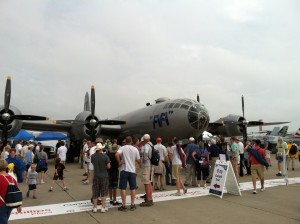
Since the 1920’s Wichita has laid claim to the title of “Air Capital of the World” without much of an argument from any other community on the planet. After all, we’ve built most of the world’s airplanes here. But, for much of the past half century, more of those airplanes show up in the same place during the same week each year at a small town in Wisconsin that is otherwise known for baby and child wear. Of course, I’m referring to Oshkosh, by gosh! Every summer since 1970 literally thousands of airplanes turn Oshkosh’s Wittman Regional Airport into the world’s busiest. They’re parked on virtually every available patch of grass and open ramp space and the adjacent fields and would-be pasture or crop land becomes America’s busiest RV park and campground. Oshkosh’s population balloons from 66,000 to over half a million for most of the month of July.
Wichita doesn’t abdicate the “Air Capital” title during the annual Experimental Aircraft Association AirVenture each summer—it just sort of “lends” it to Oshkosh. In fact, one of our own residents, Jack Pelton, is Chairman and CEO of the host organization, EAA, so the festivities in Wisconsin have a strong Wichita connection. Needless to say, our local companies are extremely well represented. GlobalParts.aero has an impressive presence with an exhibit on the grounds, a display in one of the hangars, and the company hosted a party for attendees on Wednesday evening, as well. In addition to displaying a wide array of products, including Gill batteries and Zodiac oxygen masks which it currently has in inventory at multiple sites worldwide, the company also displayed a beautifully restored Meyers 200 airplane at its exhibit and announced that it has created a Meyers 200 Racing Team. GlobalParts.aero owns the type certificate and production rights to the Meyers 200. Three of the single engine airplanes entered the AirVenture Cup Race this year and swept the first three spots in their category.
Textron Aviation also showed off their new single engine turboprop and announced it will be called the Denali, Yingling Aviation unveiled an enhanced remanufactured Ascend 172 with Garmin 500 avionics installed, BeLite Aircraft showed off its latest model, the Skydock, and RC Allen Instruments and Kelly Manufacturing were among Wichita exhibitors on hand.
While there’s lots of business being transacted at EAA AirVenture, there are numerous instances when it’s hard to keep a straight face, too. For example:
- There are various ways to arrive at the airshow—by airplane, by car, motorcycle, RV or even by boat on Lakes Winnebago or Butte de Morts, or Winneconne. All involve some type of line–even in the air. On the Sunday afternoon before the show opened we counted 26 airplanes in a queue for the E-W runway as we drove into Oshkosh from Green Lake. The crowded skies mean controllers opt for more informal and rapid-fire delivery of clearances and sequencing. You might hear something like “95 Romeo, you’re 11th in line behind a red Comanche. Land long on the final third of runway 09.” This can be problematic if you don’t know what a Comanche looks like. You find yourself thinking “I’m supposed to be following a Red Comanche but I think I’m behind an Apache…That’s the wrong Native American–The one I’m following is sending smoke signals, though!”
- On the ground, it’s the same thing, only you find yourself following all manner of high profile campers and RVs. You can’t see over or around them to read signs or pick out landmarks I was trying to go to Parking Lot B but I ended up on Highway B headed to Fond Du Lac instead.
- Once we got to the parking lot we stuffed our things in a backpack and headed to the front gate where a vast army of volunteer security people checked them for contraband. On the first day, I took my computer, a camera, a spare battery, a change of shoes, an umbrella, sun screen, a pair of binoculars, a rain poncho and some snacks. It took me 20 minutes to get to the checkpoint and 5 minutes to get everything in and out of the pack. By day 3, I had my cell phone and some Chapstick. I even left my wallet at home; I loaded a credit card on my smart phone and stuck a $20 bill in my sock. I learned to operate on the “Rule of 2”: After 2 days of carrying “necessities,” anything that can’t be consumed in the 2 hours is probably 2 heavy 2 carry 2 far!
- There are no such things as complete and well-understood conversations at EAA after about 12:30 PM. That’s when performers and aircraft start taking off in large numbers to position themselves for participation in the afternoon’s air show performances. Whether they’re solo aerobatic performers or part of the elaborate aerial ballets that range from mass fly-bys featuring every known T-33 in the Western Hemisphere to full re-enactments of the attack on Pearl Harbor punctuated by massive explosions of ordnance on or near the active runway, every demonstration flown at AirVenture between 1 PM and 5 PM each afternoon generates decibel levels that can be measured in Milwaukee, 75 miles away.
- The interruption leaves nothing to do except buy ice cream–two large scoops in a waffle cone cost the same as a seat on the board of Ben & Jerry’s, but it’s irresistible on a hot day. The ice cream melts faster than it can be eaten but it provides a reasonable means of tracking children if you know what flavors they ordered. Just follow the drips!
- Even the sky divers are loud because they have PA announcers who talk constantly. Thanks to technological improvements, the aerobatic pilots can also provide commentary on their routines while they’re flying them–but it’s done while they’re pulling 3Gs and over a headset that’s fed through the public address system so it’s about as easy to understand as the drive-through at a McDonald’s during a thunderstorm!
- Attending EAA AirVenture is like going to a State Fair on steroids that has been invaded by gigantic buzzing insects with announcers who are occasionally interrupted by lumbering jet propelled cities with wings; they dwarf all the other flying traffic. This year the massive attractions included the Martin Mars water bomber which was damaged when it actually scraped the bottom of Lake Winnebago while scooping up water for a demonstration of its ability to dump massive quantities of water (and apparently, lake bottom) on a specified target. In this case, the target was the runway at Wittman Regional Airport, where the assembled spectators who had escaped the afternoon rain showers the previous afternoon, were provided with “bonus coverage” when the giant water bomber treated them like front row audience members at a “Shamu” show at Seaword and doused them with 70,000 gallons of lake water!
- The other BIG attraction–as in larger than any of the other aircraft–was the C5-A, which was parked on Boeing Centennial Square with both its nose and tail access ramps opened for public viewing. AirVenture attendees approaching on Celebration Way could see through the giant transport. From a distance it looked like the Holland Tunnel with wings!Once EAA is over, Oshkosh returns to a semblance of normal or what for Wisconsin is considered normal. That’s where cheese, beer and the Packers replace airplanes as the most prominent things on the minds of the locals. Every Thursday at around noon, fresh cheese curds or “Squeaky cheese” is delivered to specific grocery and convenience stores (and even a few select gas stations). The knowledgeable cheesehead are on site waiting when the delivery men show up. They happily consume the cheese curds, which squeak audibly when chewed, head off to the local pub for a couple of Milwaukee’s finest, to watch coverage of the Pack on the early news and remind each other that they own a couple of shares of stock in the team. Oh, and they relinquish their month-long title as the “Air Capital of the World” and return it to its rightful owners in Wichita…at least until the same time next year!
July 20, 2016
Wichita Restoration Effort Celebrates With Short Flight on July 17.
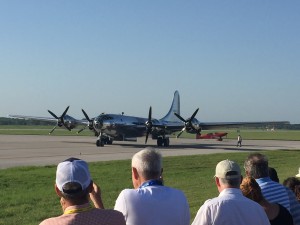
At approximately 8:50 AM CDT on Sunday morning, the worldwide fleet of flyable B-29s doubled when “Doc” lifted off from McConnell Air Force Base in Wichita, Kansas culminating a restoration project that began sixteen years ago at the factory where the airplane was built initially in 1944. Piloted by the Commemorative Air Force’s Charlie Tilghman and co-pilot David Oliver. , “Doc” joined “Fifi” as the only two Superfortresses of the 3,888 produced between 1943 and 1946 which are airworthy. “Doc” returned to the air 60 years after its last flight in 1956 when it was ferried to China Lake in California, decommissioned and hauled into the desert where it was used as a target for Naval bomber training until 1987 when Cleveland, Ohio printing executive Tony Mazzolini discovered it, largely in tact, acquired it and moved it to Wichita.
I Never Thought I’d See the Day…
Mazzolini, members of DOC’s Friends, a non-profit group formed to raise funds to support the airplane’s restoration and dozens of the volunteers who began restoring the airplane in 1991 were joined by hundreds of onlookers early on July 17, including Wichita Mayor Jeff Longwell and Kansas Fourth District Congressman Mike Pompeo, to witness the takeoff. The airplane completed high speed taxi tests on Saturday evening at around 8 PM in preparation for the first flight.
The flight itself lasted approximately 10 minutes, encompassing one takeoff, climb out to pattern altitude, and a return and landing. The crew chose to land after circling the field when a precautionary light illuminated, but the short duration of the flight didn’t dampen the enthusiasm of the crowd or their positive outlook.
“I never thought I’d see this day when we started restoring this airplane 16 years ago,” said Connie Palacioz, who at 92 years of age, remembers working on serial number 46972 when it came down the assembly line the first time in 1944.
“I prayed for good weather and a good flight when I woke up this morning. I just don’t have words to describe how I felt when I saw it in the air. It was wonderful…but a little bit sad, too, because of the volunteers who worked on it that have passed without getting to see this.”
The Town’s Talking About Doc…
Wichita’s Mayor called the event “a Wright Brothers moment for Wichita, and even though the flight wasn’t as long as we had hoped, it was still longer than their first flight! It was a perfectly fitting event for the ‘Air Capital of the World.’ ‘Doc’ now serves to unify our community and to demonstrate that we can come together and our visions can take flight. Let’s continue to work hard to keep ‘Doc’ in our community. We think it’s important to our rich history and we want make sure that future generations of Wichitans have a chance to see ‘Doc’ fly.”
“This is truly a remarkable example of the dedication and commitment by the community to honor our American Servicemen and women and and our long tradition of flight in Wichita. Its an achievement that we can be proud of for decades,” added Congressman Pompeo.
Tony Mazzolini summed up the celebration by saying, “This restoration has always been aimed at wanting to honor our veterans, to honor those who worked on these airplanes on the home front and to honor those who sacrificed so much for the cause of freedom and the American way of life. I just want to say ‘Thanks’ to all of the people who made this event today possible!’
July 1, 2016

Check out the summary below and photos in the Gallery under 2016 WAC Golf Classic.
The seventh annual Wichita Aero Club Golf Tourney was a memorable event with highlights that included great weather, great conditions, some great shots, the “Money Ball,” and a grateful scholarship recipient that greeted golfers who took their turns trying to win a brand new car! Accompanied by her father, Patrick, on Fathers Day, Talon Wanless, a senior at Wichita State University and one of two Wichita Aero Club Scholarship recipients for 2016, had the opportunity to personally thank the nearly 100 golfers who participated in this year’s WAC Golf Classic at Crestview Country Club as we kicked off a week of golf festivities that culminated in the 27th rendering of the PGA Tour’s annual championship event in Wichita, appropriately known as the web.com’s Air Capital Classic since 2012.
The tournament not only raised significant funds for the WAC Scholarship fund, it also allowed the Aero Club to contribute support to two of our members, Robin Laws and Tessa Roberts, who flew in the annual Women’s Air Race Classic last week! We plan to honor our scholarship winners, Talon Wanless and Zavier Luciano and Robin and Tessa at a later date this summer. Zavier, who’s enrolled in A&P classes at Wichita Area Technical College, wasn’t able to make it to the WAC Golf Classic, but he’s carrying a 4.0 GPA into the current semester and expressed his gratitude for the generosity of the golfers who added to the Stimpson and Humphrey scholarship funds.
Nearly $1,000 in additional contributions were raised on the day of the event by teams who purchased a “Money Ball” for $50 at the start of play–good for a “Mulligan” on any shot throughout the round. It was used to good advantage, as the winning team carded an impressive round of 53, 19 strokes under par! The “Money Ball” helped each member of the winning team win a $100 gift certificate at the Golf Warehouse for their outstanding play.
Meanwhile, we also did our part to support Wichita’s annual professional golf—and charitable event. One of only four tournaments on the PGA Tour web.com’s circuit that has been played in the same city continually over the past quarter century, the Wichita event boasts the Best Pro-Am, as voted by the players, and probably the most popular single hole on the tour, the raucous and rowdy 17th with its double-decker stadium seating, enthusiastic crowds, and great golf shots.

To say it was a “hot ticket” this year would be an understatement! Not only were the temperatures throughout the tournament hot, so was the calibre of play as the outcome came down to a three-way playoff that saw the leaders return to the 17th for a fifth time—for a playoff—and then settle the issue with a scintillating finish and a long birdie putt on the 74th hole that gave the win to Ollie Schiederjans. The Air Capital Classic generates significant funds for a variety of charities each year—including contributing to our educational initiatives, too!
May 11, 2016
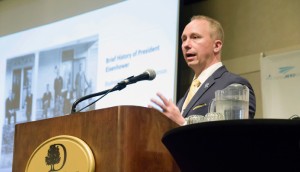 Sixty days into his new position as Director of Aviation for the Kansas Department of Transportation, Merrill Atwater took time to share his vision for the days ahead. In his address at the May meeting of the Wichita Aero Club, Atwater touched on his priorities. Chiefly: to serve as a champion of aviation.
Sixty days into his new position as Director of Aviation for the Kansas Department of Transportation, Merrill Atwater took time to share his vision for the days ahead. In his address at the May meeting of the Wichita Aero Club, Atwater touched on his priorities. Chiefly: to serve as a champion of aviation.
Aviation’s fiscal impact on the state amounts to $13.5 billion or 10 percent of its economy. Atwater wants to ensure that business owners, entrepreneurs and manufacturers know that, “Kansas is here for you.” He sees his role, his department’s and indeed the state’s as one of support to advance growth and industry improvements. “We’re here to help you. We’re a tool.”
It’s also a financial resource. The state’s airport improvement program provides matching grants to the state’s 138 public-use airports. To date, a sweet $90 million has been distributed. Funding everything from paved runways to needed equipment accomplishes many objectives. Economic stimulation. An inviting front door for business. One key goal is greater access to air ambulance services. Atwater’s working to see that 94 percent of Kansas can be reached within 30 minutes. No small feat considering Kansas’s expansive rural landscape.
During the post-presentation question-and-answer session, Atwater razzed Victor White, director of the state’s largest airport, Wichita Eisenhower National. “Victor doesn’t need our money,” said Atwater, referring to the airport’s stunning new terminal, parking garage and other improvements that have led to its ranking as the nation’s fourth-best small airport. White gamely shouted back, “Yeah we do!”
A Truly Great Great-Granddaddy
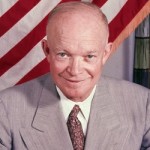 Atwater spent a good portion of his presentation talking about his great grandfather, the 34th president of the United States, Dwight D. Eisenhower. He’s rightfully proud of Eisenhower’s accomplishments and his Kansas connections.
Atwater spent a good portion of his presentation talking about his great grandfather, the 34th president of the United States, Dwight D. Eisenhower. He’s rightfully proud of Eisenhower’s accomplishments and his Kansas connections.
He was born in 1890, well before the Wright brothers’ history c flight. But aviation played a major role in his legendary life. As WWII Supreme Allied Commander in Europe, he had final say on how to use thousands of warplanes (mostly built in Kansas). He was the first president to have his pilot’s license. (He didn’t have a driver’s license.) The first to ride in a helicopter. The first to fly in the jet called Air Force One. He passed the law that led to the creation of the Federal Aviation Administration. He propelled the world into the space age by establishing the National Aeronautics and Space Administration (NASA). President Eisenhower grew up in Abilene, Kansas, but he lived his life on the world stage. Fighting for peace. Laying the groundwork for innovation. We like Ike.
Buzz for Unmanned Aerial Systems
Atwater reminded the audience that his department’s conducting a search for a director of unmanned aerial systems. It’s an industry poised for growth, he said, with projections calling for $2.9 billion in applications by 2025. He acknowledged there are issues, but communicated confidence that they will get worked out, especially with support. He looked around and said, “We need everybody in this room to participate.”
“Kansas is open for business in aviation.”
April 20, 2016
 The Air Capital of the World has reinvented itself many times as our industry has changed. Through wars, economic turmoil, regulatory changes, we have maintained our position, feeding all levels of the industry. That spirit and zeal is rooted in a love for aviation which in great part is a result of Wichita having a greater opportunity to touch aviation than anywhere else in the world. We are surrounded by the airplanes we build, support, and service, so what better way to celebrate than to operate them. The average person here still has the opportunity to live aviation as a pilot unlike most areas in the world. Although flying will never be cheap, it is as affordable as ever in Wichita.
The Air Capital of the World has reinvented itself many times as our industry has changed. Through wars, economic turmoil, regulatory changes, we have maintained our position, feeding all levels of the industry. That spirit and zeal is rooted in a love for aviation which in great part is a result of Wichita having a greater opportunity to touch aviation than anywhere else in the world. We are surrounded by the airplanes we build, support, and service, so what better way to celebrate than to operate them. The average person here still has the opportunity to live aviation as a pilot unlike most areas in the world. Although flying will never be cheap, it is as affordable as ever in Wichita.
Most all of the manufactures realized that the ability for their employees to enjoy aviation would drive their passion at work and dedication to the company. 30-60 years ago employee flying clubs were common and a great way to learn to fly, as well as enjoy aviation. With exception of Textron’s commitment to their Employee’s Flying Club, other employee flying clubs are sadly a thing of the past. The connection that resulted from these clubs is still available, but through slightly different avenues.
Just as our great city has had to navigate change and continuously reinvent itself so has The Air Capital Aviators Club. Up until 2014, they were known as the Boeing Employees Flying Club and served Boeing and Spirit employees since 1978. With the exit of Boeing from Wichita they faced the challenge of transitioning to an independent flying club. The updated charter specifically calls focus to engage employees of aviation companies and provide affordable flying options much like the traditional employee clubs of days past. The result is flying for as low as $85 per hour, proving that the $100 hamburger still exists in Wichita!
As AOPA President Mark Baker touted during his visit to our October, 2015 luncheon, Flying Clubs offer affordable flying and help curb the rising cost of aviation. As much as providing access to an aircraft, a flying club creates an aviation community. You are surrounded by others sharing the same passion to share advice, technique and encouragement. This first hand engagement in aviation is a reward to each person involved, but I also believe it benefits the companies they work for. Living aviation on the weekend provides the first hand knowledge and passion to drive success across the Air Capital at work.
I encourage you and your employees to seek an opportunity to engage locally in aviation. If you have access to an aircraft directly, through an employee club or the Air Capital Aviators Club, get out to the airport today.
Chad is currently Director of Programs for FlightSafety International at the Wichita East Learning Center. A 2001 graduate from the University of North Dakota in Commercial Aviation he gained professional experience as both an Airline and Corporate Pilot before finding his niche in aviation management. Serving as Director of Flight Operations at Ward/Kraft Inc. lead to further business experience as General Manager of their CTC printing division. Shortly after, he started Raney Aircraft Services, LLC which reinforced his desire for formal business training. After transitioning to FlightSafety International, managing the development of training curriculum and simulation for pilot and maintenance training, Chad was able to attend Wichita State University’s Executive Master of Business Administration program in 2012. A partner at the Center for Professional Business Development he provides general business training for physicians and medical professionals. He is also the Vice President of the Air Capital Aviators Club, a flying club dedicated to creating affordable flying opportunities for pilots in Wichita and the surrounding area.
February 3, 2016
If you missed the 2016 annual Aero Club Gala, check out some highlights from our Gala video.
It’s easy to be dazzled by hardware and technology. But the seventh annual Wichita Aero Club gala reminded me that people make aviation fly. Judging by all the standing ovations throughout the night, I was not alone.
The evening honors diamonds. People who are not just brilliant – but resilient. Who cut through obstacles. And make a mark. Past honorees include the late Velma Wallace, Jeff Turner and Spirit AeroSystems, John O’Leary and Airbus Americas Engineering, Russ Meyer and Al Higdon.
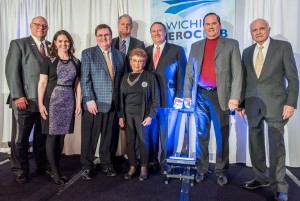 As the head of the trophy selection committee, I have the privilege of bringing together a group of highly regarded industry colleagues to bestow this honor upon a person or organization with strong Wichita ties and exemplary achievements in aviation. Here in the Air Capital, you can only imagine the number of nominees worthy of this distinction. The gala serves as an opportunity to pay respect to those who’ve made an impact on both our community and aviation.
As the head of the trophy selection committee, I have the privilege of bringing together a group of highly regarded industry colleagues to bestow this honor upon a person or organization with strong Wichita ties and exemplary achievements in aviation. Here in the Air Capital, you can only imagine the number of nominees worthy of this distinction. The gala serves as an opportunity to pay respect to those who’ve made an impact on both our community and aviation.
This year, the club saluted the Doc’s Friends Restoration Team. Since 2000, this group of volunteers donated upwards of 350,000 hours to restore Doc, a WWII-era Boeing B-29 Superfortress once part of a squadron called Snow White and the Seven Dwarfs. When it flies this spring, it will be one of only two airworthy B-29s. The U.S. Air Force’s Fifi is the other.
Humble Yet Herculean
This band of volunteers – including many retired workers from area aircraft manufacturers – started with a big challenge. The plane came to them disassembled, little more than a bunch of parts and pieces. Doc was discovered in 1987 by Tony Mazzolini in the Mojave Desert, part of a bombing target range. After years of negotiations and red tape, Doc was rescued from its ignominious (and scorching hot) home. In 2000, Doc shipped to the Wichita plant that
originally built it. And people responded. None more than 91-year-old Connie Palacioz, who stands several inches shy of five feet tall. She’s been a Doc volunteer for 16 years.
Seventy years ago Palacioz riveted this particular B-29. The nose, the only undamaged section after Doc’s years of being used as target practice, still contains Palacioz’s original rivets. She put them in when she was 17 years old. Her brother, uncle and fiancé had enlisted, she said, and “I wanted to do my part.” She did. And does. Like the hundreds of other Doc volunteers, Palacioz reminds us that we are part of something bigger. That sacrifice and dedication lead to great things.
History With a Mission
You can learn about Doc’s progress, upcoming flight and future educational efforts at www.b-29doc.com and about the Wichita Aero Club’s industry-elevating activities at www.wichitaaeroclub.org.
Photo credits: Doc image: Brett Schauf, Visual Media Group; gala images: Jeff Hetler, Visual Media Group.
This column ran in the January 28 issue of BlueSky Business Aviation News.
By Ashley Bowen Cook. Originally posted on the Greteman Group’s blog.
December 21, 2015
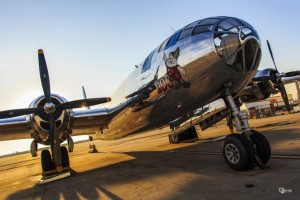 Doc’s Friends Restoration Team, the group leading the return of the B-29 known as ‘Doc’, to flyable status, received the annual Wichita Aero Club Trophy on Saturday, January 23, 2016.
Doc’s Friends Restoration Team, the group leading the return of the B-29 known as ‘Doc’, to flyable status, received the annual Wichita Aero Club Trophy on Saturday, January 23, 2016.
“This award recognizes our team of restoration volunteers, and it signifies and celebrates their great dedication to getting our historic B-29 back into the air,” said Tony Mazzolini, Doc’s Champion and the person who first identified the last restorable B-29 in 1987. “Receiving the Wichita Aero Club Trophy is testament to the long hours and tireless work these volunteers have put in since the plane was rescued from a bombing range in the Mojave Desert three decades ago.”
Fifty-eight of the Doc volunteers were in attendance and were recognized aduring the annual Wichita Aero Club Gala in January, where the trophy was presented. Mr. Mazzolini, Doc Restoration Program Manager Jim Murphy, and Connie Palacio, an authentic “Rosie the Riveter” who worked on the airplane when it was originally built in Wichita in the 1940’s spoke.
“From the beginning, this team has been focused on one thing: getting this historic warbird back into the air,” said Jim Murphy, Restoration Program Manager for Doc’s Friends. “This plane means so much to so many people. Many of our volunteers either helped build our B-29 when it came off the assembly line at Boeing Wichita in 1945 or served our nation in a B-29 during conflict. Some have even carried out their volunteer work to honor a loved one who either served our nation in a B-29 or was member of Wichita aviation work force during the 1940s and 50s.”
The restoration team recently successfully started and ran all four engines as they prepare for an Airworthiness Certificate from the FAA, which could be received in the next few weeks. Following certification, the crew will embark on ground and taxi testing before eventually entering into the test flight status. Murphy and the Doc’s Friends restoration team are hopeful they can reach the first flight milestone before the end of the year.
In order to reach the first flight milestone, Doc’s Friends held a Kickstarter fundraising campaign to cover the costs of engine, taxi, and flight-testing.
“It’s all about getting the plane back into the air,” Turner said. “Every dollar matters, and it all goes into the cost of restoring the plane. Every single pledge will make a difference, whether it’s $10, $25, or $1,000—and we’re running out of time.”
The Kickstarter campaign ran through the end of October. More information about the Kickstarter campaign can be found here.
On the web: www.b-29doc.com
On Twitter: @DocsFriends
About Doc’s Friends
Doc’s Friends is a 501c3 non-profit board managing the restoration of the Boeing B-29 Superfortress known as Doc. The group was formed in 2013 and is led by retired Spirit AeroSystems CEO Jeff Turner along with other Wichita business leaders; Charlie Chandler, Jack Pelton, Steve Clark, Lynn Nichols, Brad Gorsuch, Vic McMullen, Ron Ryan, Tim Buchanan, Jeff Peier, Esq., and Tom Bertels. Doc’s Friends is committed to returning this World War II warbird to the air to honor previous generations, educate current and future generations and connect the world to the rich heritage of aviation. You can find more information about Doc’s Friends at www.b-29doc.com.
September 22, 2015
“The ideas and alternatives we consider need to conform to the legal and safety standards of the industry and they have to make sense from an economic point of view–otherwise they literally won’t fly. But we can’t ignore the needs and requirements of the entry level prospects in general aviation or we’ll simply price ourselves out of existence.” –An EAA AirVenture attendee after looking at a remanufactured Ascend 172 in the AOPA exhibit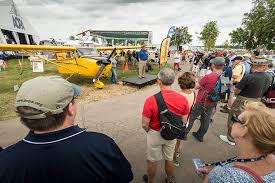
Learning to fly never seemed like a minor expense, even back in the mid-1970s when I learned to fly at one of the nation’s hundreds of Cessna Pilot Centers and a new Skyhawk II was available for less than $30,000, complete with an ARC Nav Pac. It still meant forking over $25 an hour for the airplane and $15 for the instructor and there were fees for the CPC kit, ground school, the Third Class medical, the radio operators license, the fuel–especially on the cross country flights, and the check ride. And don’t forget the $20 “wardrobe fee” after you got the shirttail cut off when you soloed on a day you didn’t expect to and wore your favorite Oxford. The more hours it took to master the “magic” of getting an airplane safely into the air and back down again, preferably at your intended destination, the more the investment. It could end up costing thousands of dollars. That was back then. Nowadays, that’s what it costs just to solo–not including the shirt!
The $30,000, which was the retail price for the airplane in 1975, is now closer to the purchase price for the flight training. Add about $400,000 to that tab if you want a new Skyhawk. Oh, you’ll get a radio package that’s a little more sophisticated than the ARC Nav Pac, a Garmin 1000 glass panel, in fact, but you’ll still get four seats, the same basic payload, and roughly the same climb, cruise, speed, and range performance and the instructor will cost about four or five times as much, but the actual experience and requirements aren’t going to be that much different–are they? Well, maybe due to video games, the availability of extraordinarily realistic simulation and computerized graphics, and the fact that kids have become familiar with joysticks and touch screens from the time they’re able to count or speak in sentences, it may not be quite as exhilarating to actually control an airplane, but traveling from place to place in half the time it takes to drive should still offer some attraction.
But, the real question isn’t whether flying or learning to fly is enough to attract potential pilots, it’s whether the cost to acquire an airplane or flight training is so high that it will eventually–and perhaps rapidly–result in the end of pilot education as we’ve known it. The private pilot will become a part of history. General Aviation flying will be virtually non-existent, or about as common as that of classic warbirds and collectible aircraft–making appearances at rare, weekend fly-ins where the curious can come out, pay a fee to see the privately-owned, owner-flown airplanes of the past when real human beings actually got behind the controls and controlled the aircraft themselves–and could afford to do so.
Today’s airframe manufacturers really seem to think that several hundred thousand dollars is not too much to charge for a four-place airplane that will fly less than 1000 miles on a tank of gas at less than 200 miles per hour. The concept of taking the family on a day trip for the proverbial “$100 hamburger” is fast being relegated to the annals of history, too. The $100 hamburger is more like a $800 Quinoa and Tofu burger.
The alternative is to offer ways to acquire and update existing airplanes–there are still tens of thousands of flyable Cessnas, Pipers, Beechcraft, Cirrus, Mooneys, Meyers, Bellancas and others out there–that can be revitalized and utilized, even in the Next Generation air traffic control system, if the industry doesn’t shoot itself in the foot trying to regulate and price itself out of existence. There are some great companies out there that have the legacy airplane owners in mind. Yingling Aviation is one: they’ve announced a “remanufactured 172” that is an exceptional value and brings 30 year old airframes up to nearly new specs and performance, complete with glass cockpits if desired, at about a third the cost of a new airplane. TKM in Phoenix offers “plug and play” replacement avionics for legacy models and they’ll work with and allow older airplanes to operate in the Next Gen environment. There are companies actively working on alternative fuels and engine technology to keep those airplanes flying if and when 100LL becomes 100 % unavailable, too. It’s really time to give these guys some attention and some support so they can give the dwindling, existing pilot population some encouragement and the prospective pilot population some hope that they’ll be able to afford to get a pilot’s license–one that won’t cost them the shirt off their back!


